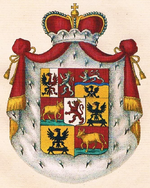| House of Auersperg | |
|---|---|
 Arms of the Princes of Auersperg | |
| Country | Holy Roman Empire Austrian Empire Austro-Hungarian Empire |
| Place of origin | Auersperg Castle (Slovene: Grad Turjak, German: Burg Auersperg) |
| Founded | 12th century |
| Current head | Carl Adolf |
| Final ruler | Wilhelm I |
| Titles | Prince of Auersperg Duke of Gottschee Duke of Münsterberg Princely Count of Tengen Princely Count of Wels Count of Auersperg Lord of Schönberg Lord of Seisenberg |
| Style(s) | Serene Highness |
| Deposition | 1806: Dissolution of the Holy Roman Empire |
| Cadet branches | Auersperg-Breunner Auersperg-Trautson |
The House of Auersperg (Slovene: Auerspergi or Turjaški) is an Austrian princely family and formerly one of the most prominent European noble houses. The family originates from the comital line of Auersperg in the Duchy of Carniola during the Middle Ages and belongs to the high nobility (one of the Mediatised Houses, or former Sovereign families).
The Auerspergs held the rank of Princes of the Holy Roman Empire from 1653 and had an individual vote (Virilstimme) in the College of Princes of the Imperial Diet from 1664.[1] They also held at various times the duchies of Münsterberg and Gottschee. Following the dissolution of the Holy Roman Empire 1806, their Imperial State was mediatised to the Grand Duchy of Baden. The Auerspergs remained one of the most prominent families in the Austrian Empire and later Austro-Hungarian Empire, most notably serving as generals, prime ministers of the western half of the empire (Minister-President of Cisleithania) and presidents of the Austrian House of Lords.
- ^ Ruvigny and Raineval, Melville Henry Massue. The Titled Nobility of Europe : An International Peerage or Who’s Who of the Sovereigns, Princes and Nobles of Europe. Facsim. ed., Burke’s Peerage, 1980. (Google Books)